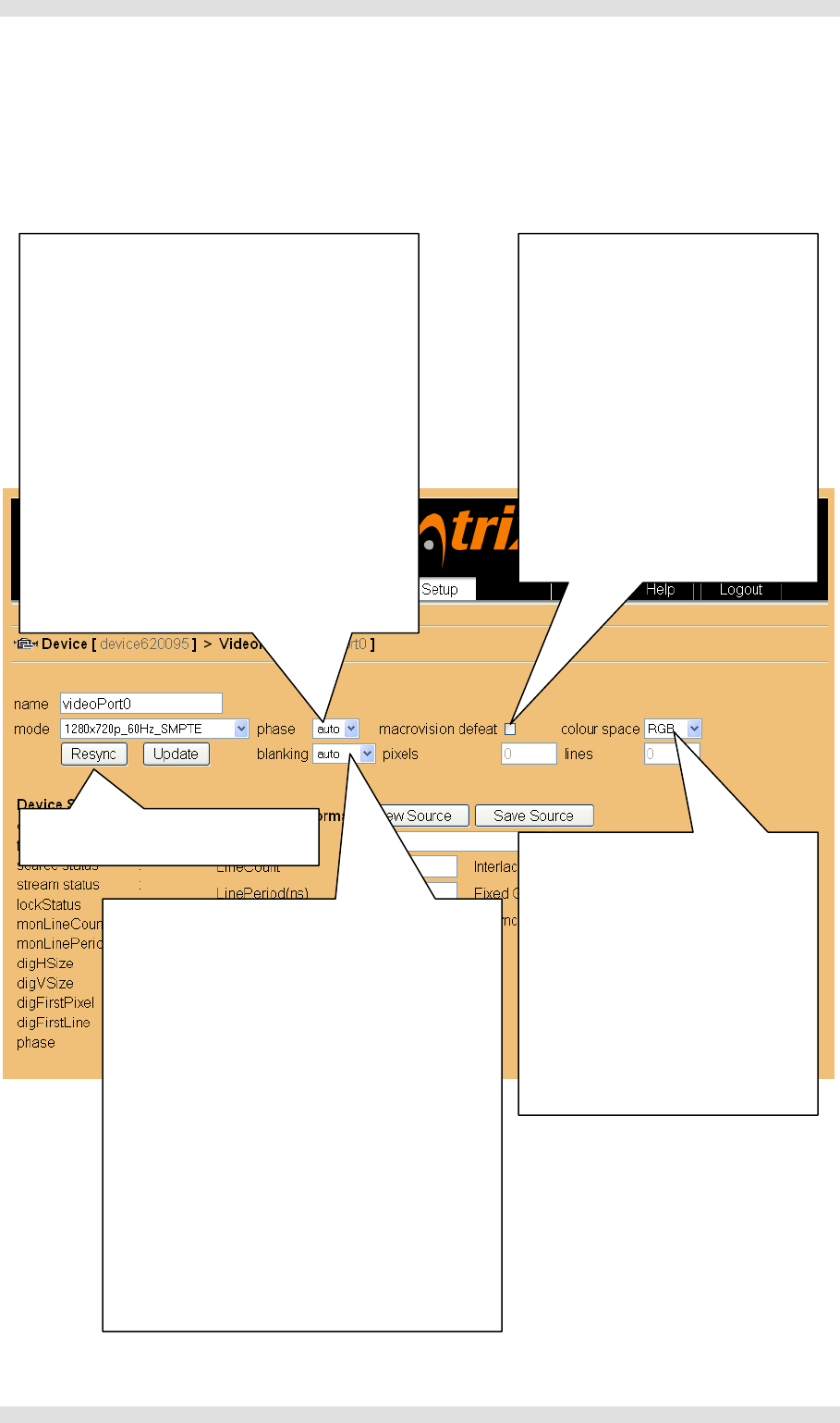User Guide User guide
Table Of Contents
- What is VN-MATRIX?
- Functional Overview
- Example System Application
- Front Panel Features
- Rear Panel Features
- Accessories
- Choosing a Suitable Location
- Mains Power Connection (via PSU)
- Mains Power Cord (for PSU)
- Setup and Connection Procedure
- The VN-MATRIX Web Interface
- Configuring a VN-MATRIX as an Encoder (source)
- Configuring a VN-MATRIX as a Decoder (display)
- Troubleshooting
- Encoder Set Up
- Decoder Set Up
- System Set Up
- Overview
- Setting-up a Serial Data Stream
- Setting-up a Serial Passthrough Group
- Setting-up a Remote Control Group
- Serial / Telnet Commands
- Overview
- VN-MATRIX Hardware
- Serial Interface – Quick Reference
- Telnet Interface – Quick Reference
- Web Interface – Quick Reference
- Network Characteristics

VN-MATRIX User Guide Section 4: Advanced Setup Procedures
I458GB issue 6 Page 65
Fine-Tuning a Source (manual overrides)
The following adjustments are classed as manual overrides. The chosen settings are not saved as
part of the current source mode and, once applied, will remain in force until they are changed.
Blanking (Image Positioning)
In analog video/graphics sources, active video occupies
an area in the middle of the video frame. Around this is a
non-active area used for horizontal and vertical blanking
signals.
VN-MATRIX normally ignores the blanking area and
only digitizes the active video area. To do this it needs to
know the position of the first active line of video and the
first active pixel on that line. This is controlled by the
blanking parameter. This is normally set to auto which
allows VN-MATRIX to calculate the values
automatically.
If required, the calculated values for first line and first
pixel can be adjusted by applying a manual offset. To do
this set the blanking parameter to manual and type a
positive or negative integer value into the pixels or lines
fields as required and click update.
NOTE: The offsets are made relative to the current
Source Format ‘digFirstPixel’ and ‘digFirstLine’ values.
Color Space (RGB / YPrPb)
Because of the similarity between analog
RGsB (sync on green) and component
YPrPb signals, sources using these
transports may not auto-detect correctly.
RGsB and YPrPB source have different
color spaces and if the wrong setup is
applied the resulting image although
stable will have a red or green color cast.
Set the color space parameter to either
RGB or YPrPb as required.
Phase (Pixel Clock)
When an analog graphics signal is being digitized it is
essential that each pixel is sampled as close as possible
to its center in order to obtain a stable value. Sampling
too close to a pixel boundary will cause unreliable data
capture and result in noise or artifacts, especially
between pixels of significantly different hue or intensity.
Normally phase is set to auto. This allows VN-MATRIX
to automatically determine the optimum clock phase.
If the auto setting proves unsatisfactory for any reason,
try adjusting the phase manually by selecting a value
between +32 and -32. Positive numbers advance the
clock phase relative to the start of the active line while
negative numbers retard the clock phase.
HINT: Optimum phase adjustment is easier to establish
when a suitable test pattern is displayed. Typically, this
will comprise a series of alternating black and white
vertical lines at one pixel intervals.
Macrovision Defeat
Macrovision copy protection is often
applied to commercially produced videos
and DVDs. This adds additional sync-
level pulses to the video waveform and
these need to be ignored for proper auto-
detection on VN-MATRIX.
If you know (or suspect) that your source
material has Macrovision encoding, tick
the Macrovision defeat option on the
Video Setup page.
Leave this parameter unticked for all
other sources. Ticking this parameter for
non-Macrovision sources may result in
‘tearing’ at the top of the image.
HINT: Click Resync to force an
auto-detection of the source.










